Strength Development and Microstructural Behavior of Soils Stabilized with Palm Oil Fuel Ash (POFA)-Based Geopolymer
Abstract
1. Introduction
2. Materials and Methods
2.1. Materials
2.1.1. Soil
2.1.2. Palm Oil Fuel Ash (POFA)
2.1.3. Alkaline Activator
2.1.4. POFA-Based Geopolymer
2.1.5. Samples Preparation
2.2. Methods
2.2.1. Standard Proctor Compaction Test
2.2.2. Unconfined Compressive Strength (UCS)
2.2.3. Direct Shear Test (DST)
2.2.4. Microstructural Analysis
3. Results and Discussion
3.1. Compaction Behavior
3.2. Unconfined Compressive Strength
3.3. Direct Shear Test
3.4. Microstructural Analysis
4. Conclusions
- Based on the findings, the prepared geopolymer consisting of POFA as source material and NaOH along with Na2SiO3 as alkali activators was successful in enhancing the properties of the soil. However, the geotechnical properties of soil treated using POFA-based geopolymer depend mainly on the dosage of the binder, the host soil type and the curing conditions.
- POFA-based geopolymer-treated clayey soil specimens have been shown to have higher MDD values than untreated samples, with a drop in the accompanying OMC as the geopolymer dosage rises, which is an indication of improvement.
- The UCS results demonstrated that the maximum strength was accomplished by the geopolymer mixture consisting of the highest POFA percentage (G40PA) at both curing times. At 28 days, the effect of POFA-based geopolymer was more obvious due to the development of greater strength compared with 7 days curing. In addition, the shear strength parameters—especially cohesion of soil—were improved due to the addition of POFA-based geopolymer even without curing.
- Apart from the positive outcomes shown by the current research, the application of POFA-based geopolymer to low and high plasticity clayey soils played a significant role in changing the soils’ structure where the detached particles of soils in treated mixes have shown that they become more closely tied together, with the voids apparently filled, leading to a significant improvement in strength, as depicted in FESEM-EDX photographs. In addition, EDX confirmed that NASH gel is the most likely formed gel in the treated soils
Author Contributions
Funding
Institutional Review Board Statement
Informed Consent Statement
Data Availability Statement
Acknowledgments
Conflicts of Interest
References
- Asgari, M.R.; Baghebanzadeh Dezfuli, A.; Bayat, M. Experimental study on stabilization of a low plasticity clayey soil with cement/lime. Arab. J. Geosci. 2015, 8, 1439–1452. [Google Scholar] [CrossRef]
- Firoozi, A.A.; Guney Olgun, C.; Baghini, M.S. Fundamentals of soil stabilization. Int. J. Geo Eng. 2017, 8, 26. [Google Scholar] [CrossRef]
- Wang, D.; Zentar, R.; Abriak, N.E. Durability and Swelling of Solidified/Stabilized Dredged Marine Soils with Class-F Fly Ash, Cement, and Lime. J. Mater. Civ. Eng. 2018, 30, 04018013. [Google Scholar] [CrossRef]
- Albitar, M.; Visintin, P.; Mohamed Ali, M.S.; Drechsler, M. Assessing behaviour of fresh and hardened geopolymer concrete mixed with class-F fly ash. KSCE J. Civ. Eng. 2015, 19, 1445–1455. [Google Scholar] [CrossRef]
- Du, Y.-J.; Bo, Y.-L.; Jin, F.; Liu, C.-Y. Durability of reactive magnesia-activated slag-stabilized low plasticity clay subjected to drying–wetting cycle. Eur. J. Environ. Civ. Eng. 2015, 20, 215–230. [Google Scholar] [CrossRef]
- Jafer, H.; Atherton, W.; Sadique, M.; Ruddock, F.; Loffill, E. Stabilisation of soft soil using binary blending of high calcium fly ash and palm oil fuel ash. Appl. Clay Sci. 2018, 152, 323–332. [Google Scholar] [CrossRef]
- Chang, I.; Im, J.; Prasidhi, A.K.; Cho, G.-C. Effects of Xanthan gum biopolymer on soil strengthening. Constr. Build. Mater. 2015, 74, 65–72. [Google Scholar] [CrossRef]
- Criado, M.; Fernández-Jiménez, A.; De La Torre, A.G.; Aranda, M.A.G.; Palomo, A. An XRD study of the effect of the SiO2/Na2O ratio on the alkali activation of fly ash. Cem. Concr. Res. 2007, 37, 671–679. [Google Scholar] [CrossRef]
- Aziz, I.H.; Al Bakri Abdullah, M.M.; Cheng Yong, H.; Yun Ming, L.; Hussin, K.; Azimi, E.A. A Review on Mechanical Properties of Geopolymer Composites for High Temperature Application. Key Eng. Mater. 2015, 660, 34–38. [Google Scholar] [CrossRef]
- Senol, A.; Bin-Shafique, M.S.; Edil, T.B.; Benson, C.H. Use of Class C Fly Ash for Stabilization of Soft Subgrade. In Fifth Inter-national Congress on Advances in Civil Engineering; Istanbul Technical University: Maslak, Turkey, 2002; pp. 25–27. [Google Scholar]
- Majidi, B. Geopolymer technology, from fundamentals to advanced applications: A review. Mater. Technol. 2009, 24, 79–87. [Google Scholar] [CrossRef]
- Fernández-Jiménez, A.; De La Torre, A.G.; Palomo, A.; López-Olmo, G.; Alonso, M.M.; Aranda, M.A.G. Quantitative determination of phases in the alkaline activation of fly ash. Part II: Degree of reaction. Fuel 2006, 85, 1960–1969. [Google Scholar] [CrossRef]
- Van Riessen, A.; Jamieson, E.; Kealley, C.S.; Hart, R.D.; Williams, R.P. Bayer-geopolymers: An exploration of synergy between the alumina and geopolymer industries. Cem. Concr. Compos. 2013, 41, 29–33. [Google Scholar] [CrossRef]
- Wang, S.; Xue, Q.; Zhu, Y.; Li, G.; Wu, Z.; Zhao, K. Experimental study on material ratio and strength performance of geopolymer-improved soil. Constr. Build. Mater. 2020, 267, 120469. [Google Scholar] [CrossRef]
- Zhu, Y.; Chen, R.; Lai, H. Stabilizing Soft Ground Using Geopolymer: An Experimental Study. In Proceedings of the CICTP 2020, Xi’an, China, 14–16 August 2020; American Society of Civil Engineers (ASCE): Reston, VA, USA; pp. 1144–1155. [Google Scholar]
- Dheyab, W.; Ismael, Z.T.; Hussein, M.A.; Huat, B.B.K. Soil Stabilization with geopolymers for low cost and environmentally friendly construction. Int. J. Geomate 2019, 17, 271–280. [Google Scholar] [CrossRef]
- Teing, T.T. Effects of Alkali-Activated Waste Binder in Soil Stabilization. Int. J. Geomate 2019, 17, 82–89. [Google Scholar] [CrossRef]
- Khan, M.A.; Wang, J.X.; Sarker, D. Stabilization of Highly Expansive Moreland Clay Using Class-C Fly Ash Geopolymer (CFAG). In Proceedings of the IFCEE 2018, Orlando, FL, USA, 6 June 2018; American Society of Civil Engineers (ASCE): Orlando, FL, USA, 2018; pp. 505–518. [Google Scholar]
- Rivera, J.F.; Orobio, A.; Mejía De Gutiérrez, R.; Cristelo, N. Clayey soil stabilization using alkali-activated cementitious materials. Mater. Construcción 2020, 70, 211. [Google Scholar] [CrossRef]
- Abdullah, H.H.; Shahin, M.A.; Walske, M.L.; Karrech, A. Systematic approach to assessing the applicability of fly-ash-based geopolymer for clay stabilization. Can. Geotech. J. 2020, 57, 1356–1368. [Google Scholar] [CrossRef]
- Liu, M.Y.J.; Chua, C.P.; Alengaram, U.J.; Jumaat, M.Z. Utilization of Palm Oil Fuel Ash as Binder in Lightweight Oil Palm Shell Geopolymer Concrete. Adv. Mater. Sci. Eng. 2014, 2014, 1–6. [Google Scholar] [CrossRef]
- Abdeldjouad, L.; Asadi, A.; Nahazanan, H.; Huat, B.B.K.; Dheyab, W.; Elkhebu, A.G. Effect of Clay Content on Soil Stabilization with Alkaline Activation. Int. J. Geosynth. Ground Eng. 2019, 5, 4. [Google Scholar] [CrossRef]
- Sukmak, P.; Sukmak, G.; Horpibulsuk, S.; Setkit, M.; Kassawat, S.; Arulrajah, A. Palm oil fuel ash-soft soil geopolymer for subgrade applications: Strength and microstructural evaluation. Road Mater. Pavement Des. 2019, 20, 110–131. [Google Scholar] [CrossRef]
- Khasib, I.A.; Daud, N.N.N. Physical and Mechanical Study of Palm Oil Fuel Ash (POFA) based Geopolymer as a Stabilizer for Soft Soil. Pertanika J. Sci. Technol. 2020, 28, 149–160. [Google Scholar] [CrossRef]
- Noor Azline, M.N.; Abd Aziz, F.N.A.; Suleiman Juma, A. Effect of Ground Granulated Blast Furnace Slag on Compressive Strength of POFA Blended Concrete. Appl. Mech. Mater. 2015, 802, 142–148. [Google Scholar] [CrossRef]
- Islam, A.; Alengaram, U.J.; Jumaat, M.Z.; Bashar, I.I. The development of compressive strength of ground granulated blast furnace slag-palm oil fuel ash-fly ash based geopolymer mortar. Mater. Des. 2014, 56, 833–841. [Google Scholar] [CrossRef]
- Ranjbar, N.; Mehrali, M.; Behnia, A.; Alengaram, U.J.; Jumaat, M.Z. Compressive strength and microstructural analysis of fly ash/palm oil fuel ash based geopolymer mortar. Mater. Des. 2014, 59, 532–539. [Google Scholar] [CrossRef]
- Tangchirapat, W.; Saeting, T.; Jaturapitakkul, C.; Kiattikomol, K.; Siripanichgorn, A. Use of waste ash from palm oil industry in concrete. Waste Manag. 2007, 27, 81–88. [Google Scholar] [CrossRef]
- Pourakbar, S.; Asadi, A.; Huat, B.B.K.; Cristelo, N.; Fasihnikoutalab, M.H. Application of Alkali-Activated Agro-Waste Reinforced with Wollastonite Fibers in Soil Stabilization. J. Mater. Civ. Eng. 2017, 29, 04016206. [Google Scholar] [CrossRef]
- Salih, M.A. New Geo-Polymerization Process for High for High Strength Alkali Activated Binder with Palm Oil Fuel Ash and Ground Granulated Blast Furnace Slag. Ph.D.Thesis, Universiti Putra Malaysia, Seri Kembangan, Malaysia, 2015. [Google Scholar]
- Vitale, E.; Russo, G.; Deneele, D. Use of Alkali-Activated Fly Ashes for Soil Treatment. In Geotechnical Research for Land Protec-tion and Development; Calvetti, F., Cotecchia, F., Galli, A., Jommi, C., Eds.; Lecture Notes in Civil Engineering; Springer Inter-national Publishing: Cham, Switzerland, 2020; Volume 40, pp. 723–733. ISBN 978-3-030-21358-9. [Google Scholar]
- Abdullah, H.H.; Shahin, M.A.; Sarker, P. Use of Fly-Ash Geopolymer Incorporating Ground Granulated Slag for Stabilisation of Kaolin Clay Cured at Ambient Temperature. Geotech. Geol. Eng. 2018, 37, 721–740. [Google Scholar] [CrossRef]
- Cristelo, N.; Glendinning, S.; Teixeira Pinto, A. Deep soft soil improvement by alkaline activation. Proc. Inst. Civ. Eng. Ground Improv. 2011, 164, 73–82. [Google Scholar] [CrossRef]
- Abdullah, H.H.; Shahin, M.A.; Walske, M.L. Geo-mechanical behavior of clay soils stabilized at ambient temperature with fly-ash geopolymer-incorporated granulated slag. Soils Found. 2019, 59, 1906–1920. [Google Scholar] [CrossRef]
- Arshad, A.K.; Shaffie, E.; Ismail, F.; Hashim, W.; Rahman, Z.A.; Ismail, Y. Cement stabilised soil subgrade: Design and con-struction. Int. J. Civ. Eng. Technol. 2018, 9, 1192–1200. Available online: http://www.iaeme.com/ijciet/issues.asp?JType=IJCIET&VType=9&IType=7 (accessed on 1 July 2018).
- Pourakbar, S.; Asadi, A.; Huat, B.B.K.; Fasihnikoutalab, M.H. Soil stabilisation with alkali-activated agro-waste. Environ. Geotech. 2015, 2, 359–370. [Google Scholar] [CrossRef]
- Sharma, P.K.; Singh, J.P.; Kumar, A. Effect of Particle Size on Physical and Mechanical Properties of Fly Ash Based Geopolymers. Trans. Indian Inst. Met. 2019, 72, 1323–1337. [Google Scholar] [CrossRef]
- Fernández-Jiménez, A.; Palomo, A. Characterisation of fly ashes. Potential reactivity as alkaline cements. Fuel 2003, 82, 2259–2265. [Google Scholar] [CrossRef]
- Nurwidayati, R.; Ulum, M.B.; Ekaputri, J.J.; Suprobo, P. Characterization of Fly Ash on Geopolymer Paste. Mater. Sci. Forum 2016, 841, 118–125. [Google Scholar] [CrossRef]
- Phummiphan, I.; Horpibulsuk, S.; Sukmak, P.; Chinkulkijniwat, A.; Arulrajah, A.; Shen, S.-L. Stabilisation of marginal lateritic soil using high calcium fly ash-based geopolymer. Road Mater. Pavement Des. 2016, 17, 877–891. [Google Scholar] [CrossRef]
- Abdullah, H.H.; Shahin, M.A.; Walske, M.L. Review of Fly-Ash-Based Geopolymers for Soil Stabilisation with Special Reference to Clay. Geosciences 2020, 10, 249. [Google Scholar] [CrossRef]
- Latifi, N.; Vahedifard, F.; Ghazanfari, E.; Horpibulsuk, S.; Marto, A.; Williams, J. Sustainable Improvement of Clays Using Low-Carbon Nontraditional Additive. Int. J. Géoméch. 2018, 18, 04017162. [Google Scholar] [CrossRef]
- Horpibulsuk, S.; Miura, N.; Bergado, D.T. Undrained Shear Behavior of Cement Admixed Clay at High Water Content. J. Geotech. Geoenviron. Eng. 2004, 130, 1096–1105. [Google Scholar] [CrossRef]
- Tan, T.; Huat, B.B.K.; Anggraini, V.; Shukla, S.K.; Nahazanan, H. Strength Behavior of Fly Ash-Stabilized Soil Reinforced with Coir Fibers in Alkaline Environment. J. Nat. Fibers 2019, 1–14. [Google Scholar] [CrossRef]
- Khale, D.; Chaudhary, R. Mechanism of geopolymerization and factors influencing its development: A review. J. Mater. Sci. 2007, 42, 729–746. [Google Scholar] [CrossRef]
- Cristelo, N.; Glendinning, S.; Fernandes, L.; Pinto, A.T. Effect of calcium content on soil stabilisation with alkaline activation. Constr. Build. Mater. 2012, 29, 167–174. [Google Scholar] [CrossRef]
- Pacheco-Torgal, F.; Castro-Gomes, J.; Jalali, S. Alkali-activated binders: A review. Part 2. About materials and binders manufacture. Constr. Build. Mater. 2008, 22, 1315–1322. [Google Scholar] [CrossRef]
- Shi, C.; Jiménez, A.F.; Palomo, A. New cements for the 21st century: The pursuit of an alternative to Portland cement. Cem. Concr. Res. 2011, 41, 750–763. [Google Scholar] [CrossRef]
- Chen, R.; Zhu, Y.; Lai, H.P.; Bao, W. Stabilization of soft soil using low-carbon alkali-activated binder. Environ. Earth Sci. 2020, 79, 510. [Google Scholar] [CrossRef]
- Corrêa-Silva, M.; Araujo, N.; Cristelo, N.; Miranda, T.; Gomes, A.T.; Coelho, J. Improvement of a clayey soil with alkali activated low-calcium fly ash for transport infrastructures applications. Road Mater. Pavement Des. 2018, 20, 1912–1926. [Google Scholar] [CrossRef]
- Kamaruddin, F.A.; Nahazanan, H.; Kim Huat, B.; Anggraini, V. Improvement of Marine Clay Soil Using Lime and Alkaline Activation Stabilized with Inclusion of Treated Coir Fibre. Appl. Sci. 2020, 10, 2129. [Google Scholar] [CrossRef]

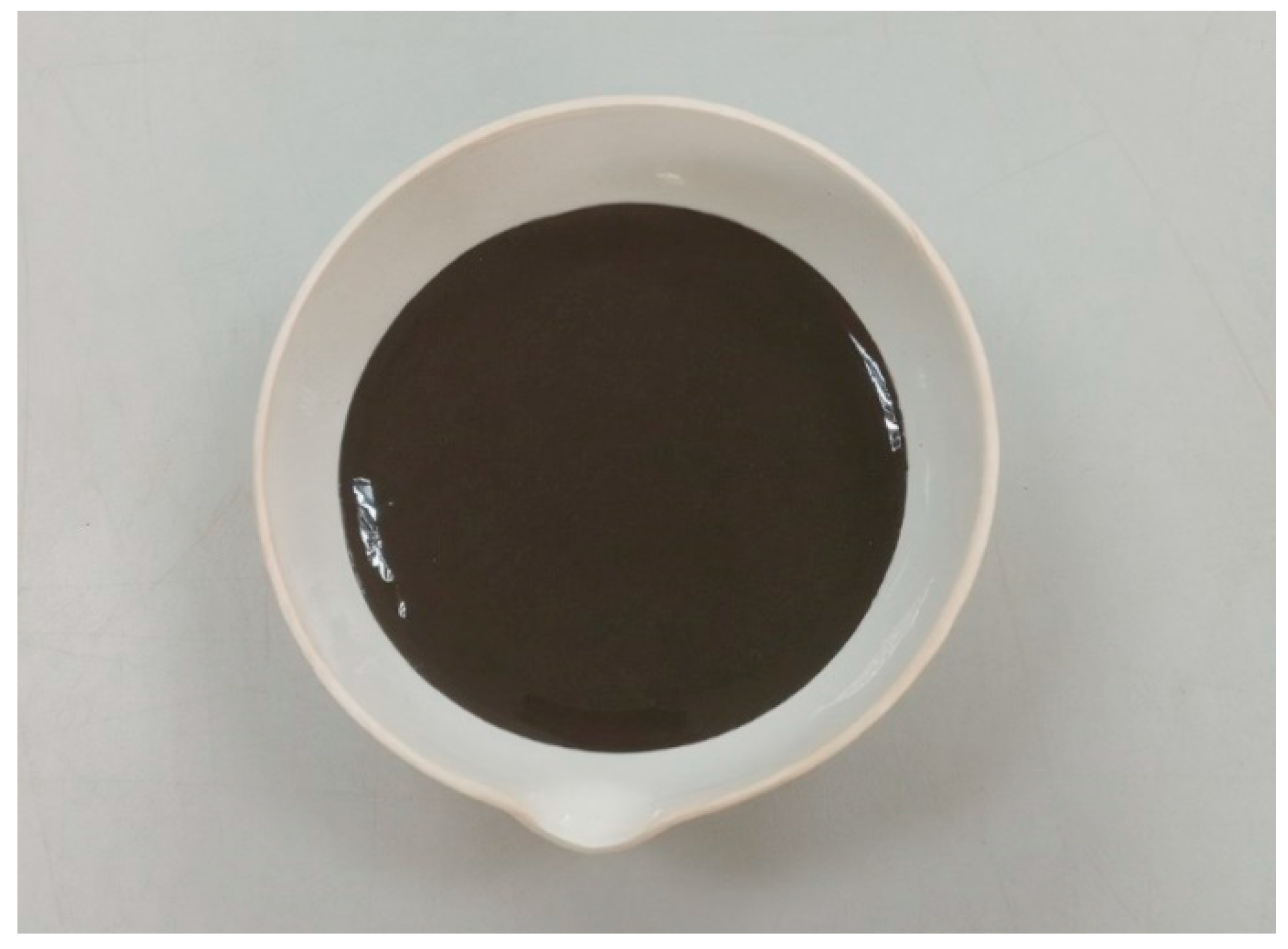
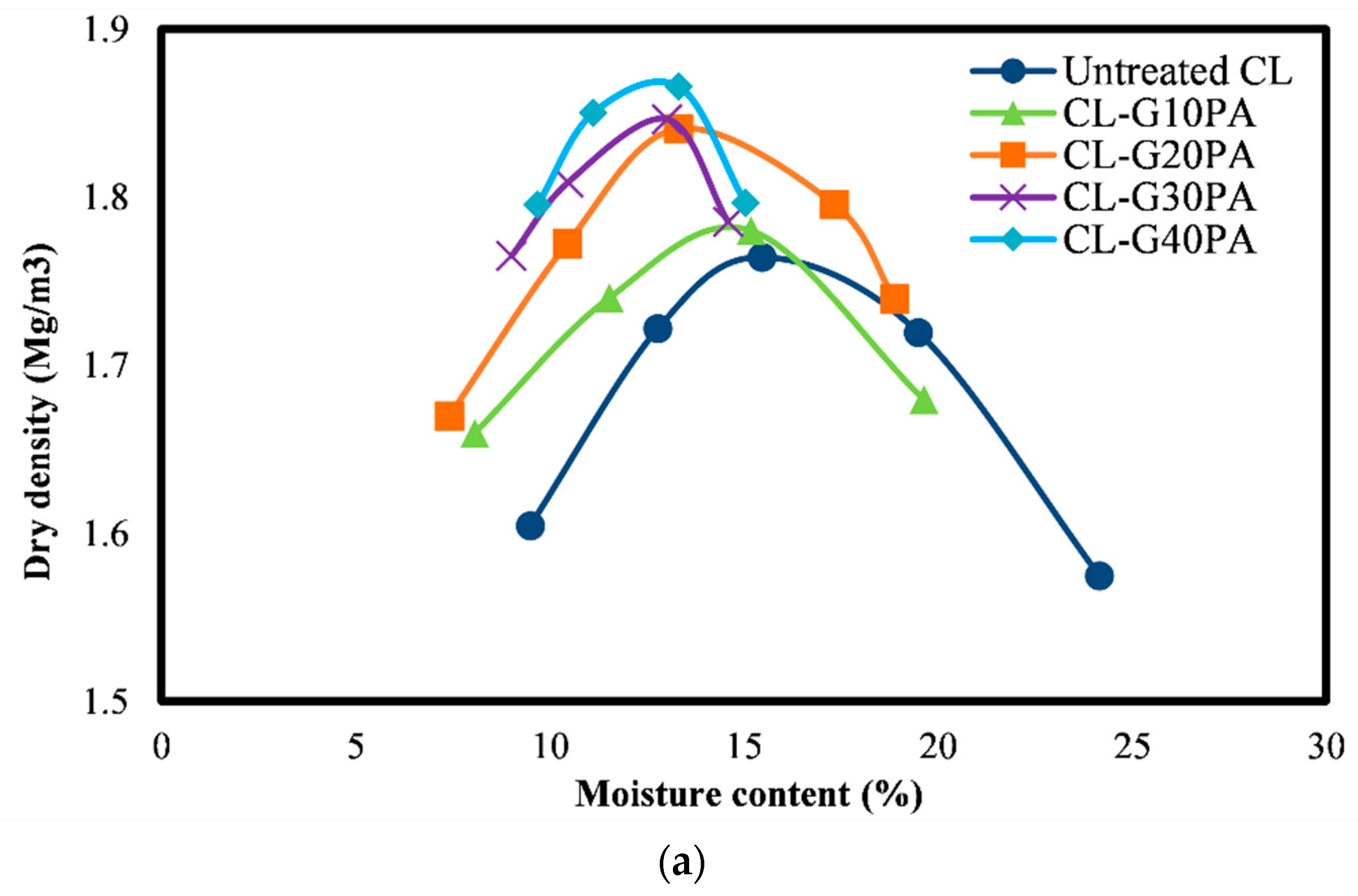
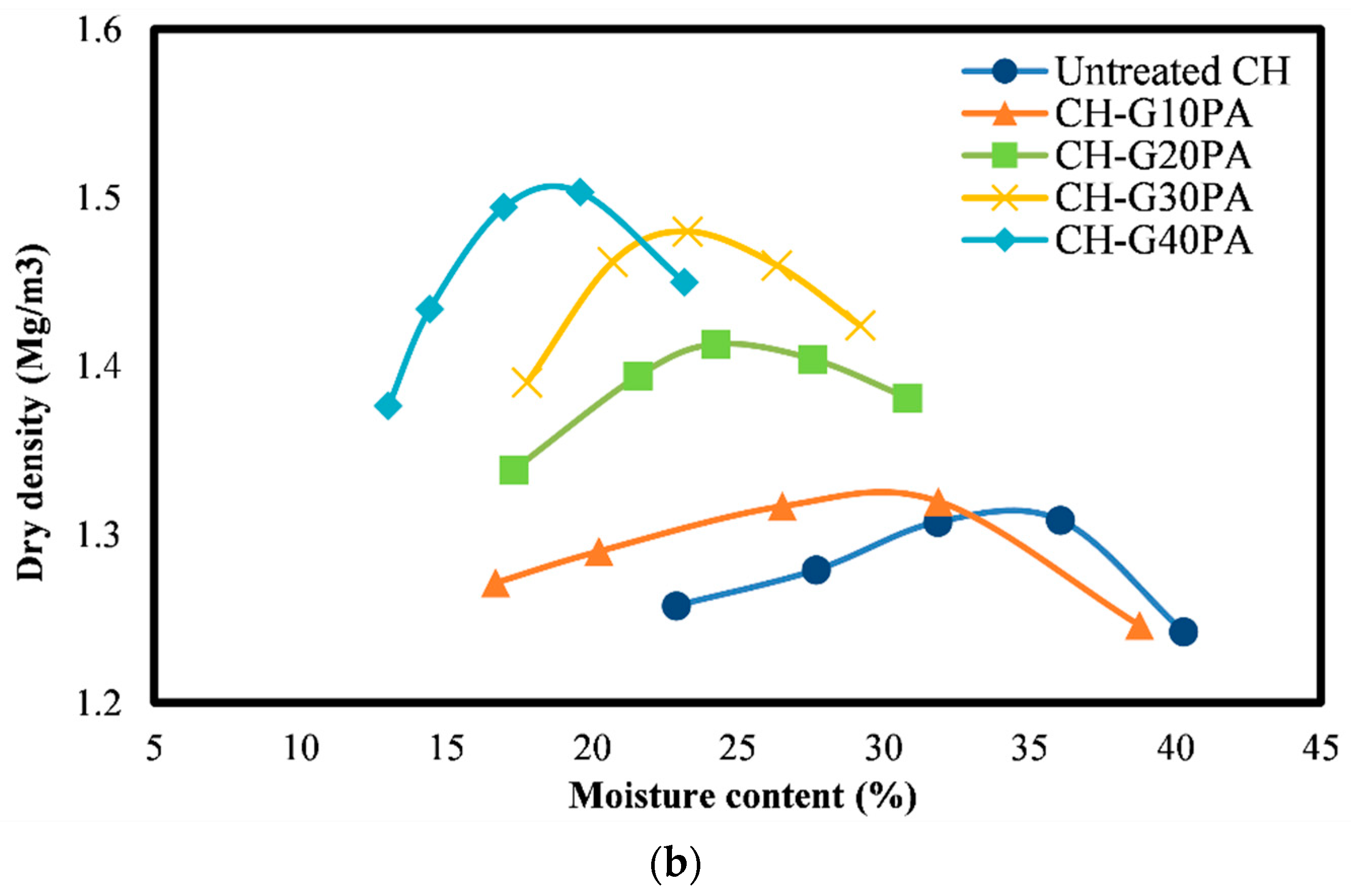
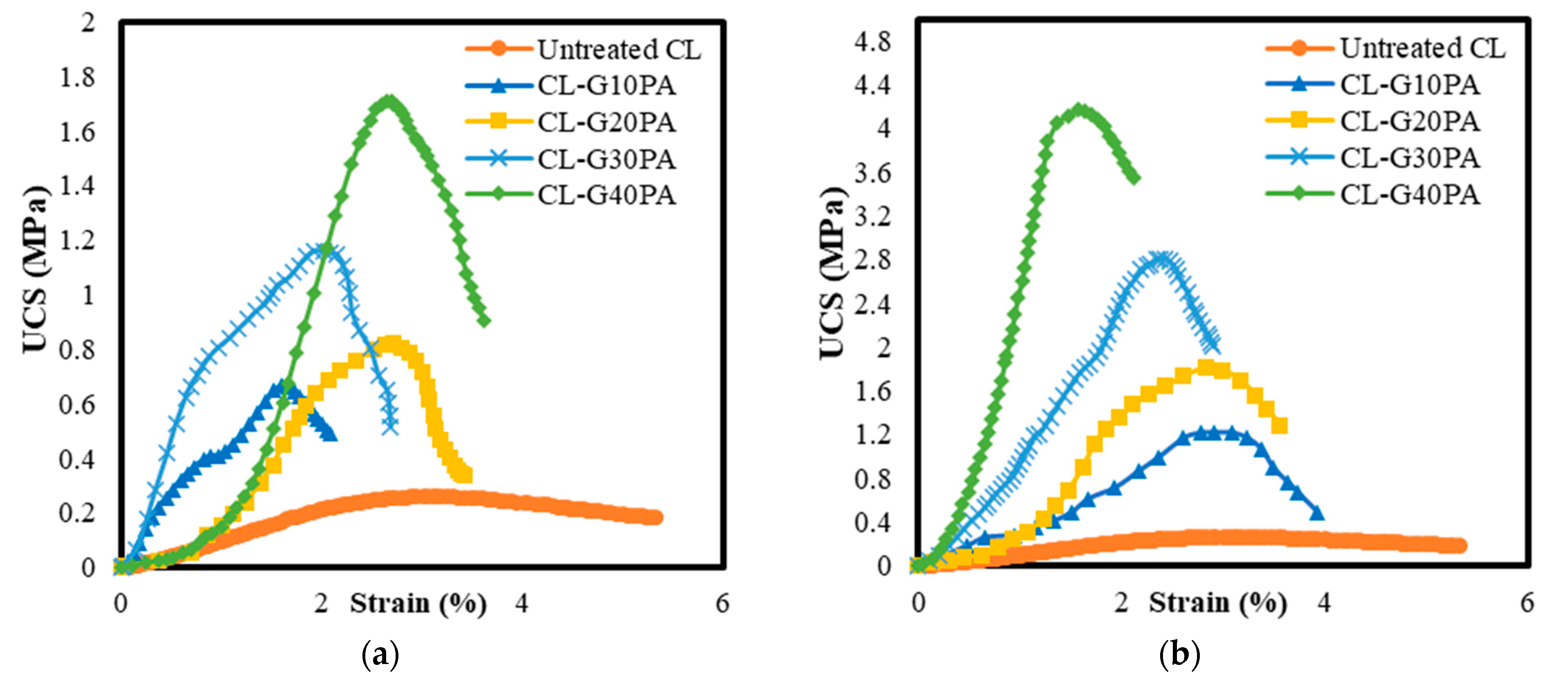

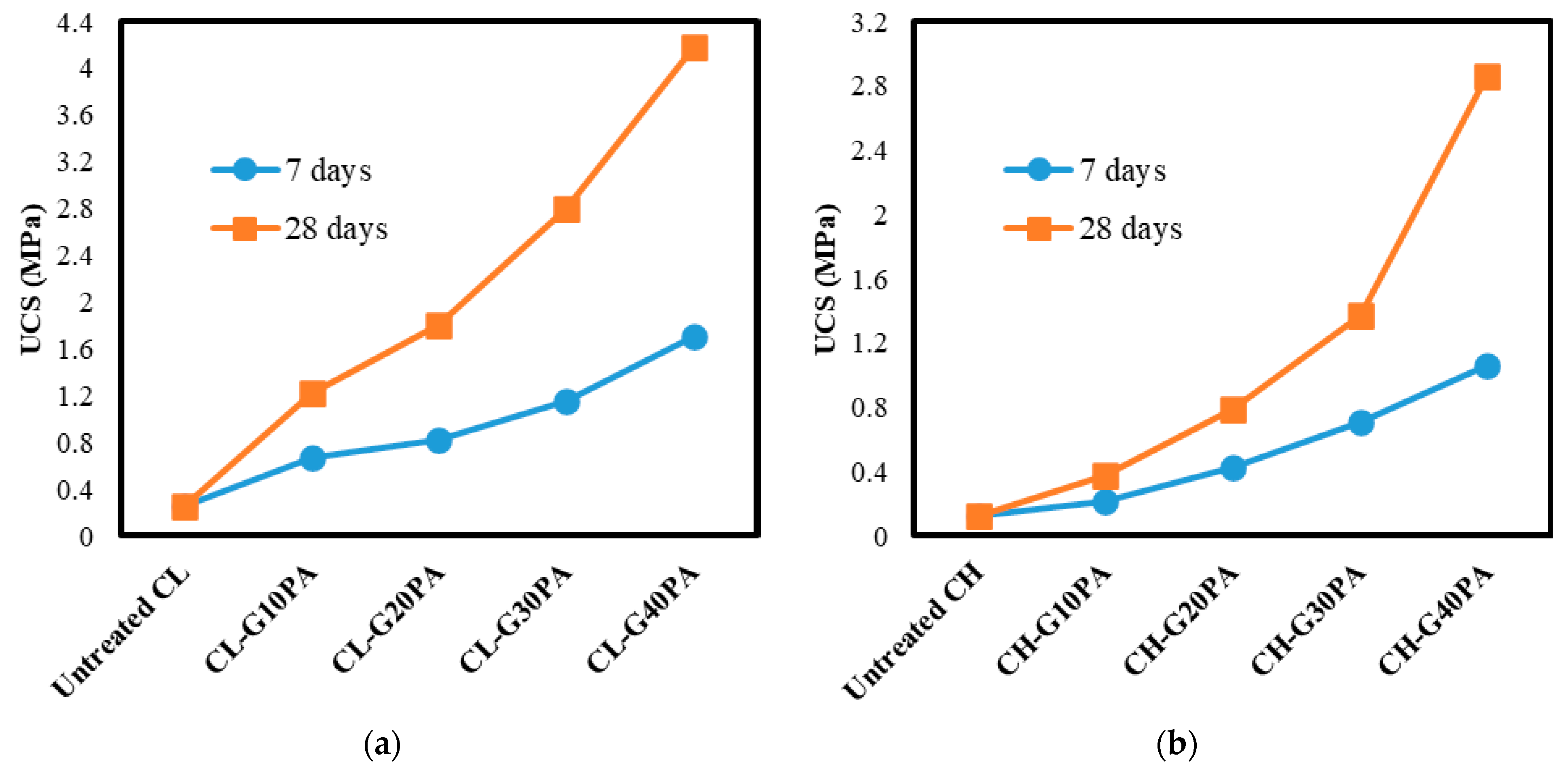
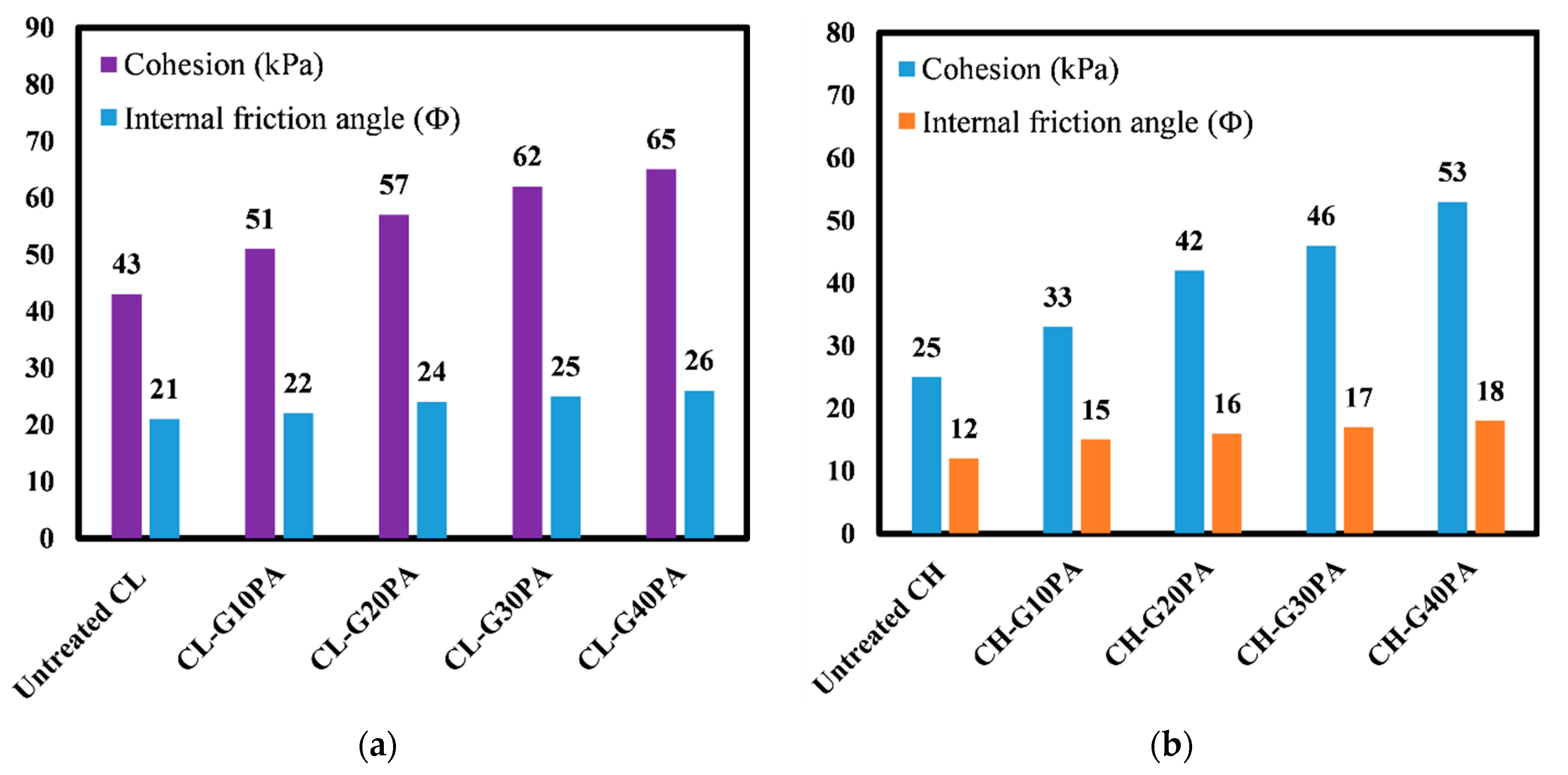
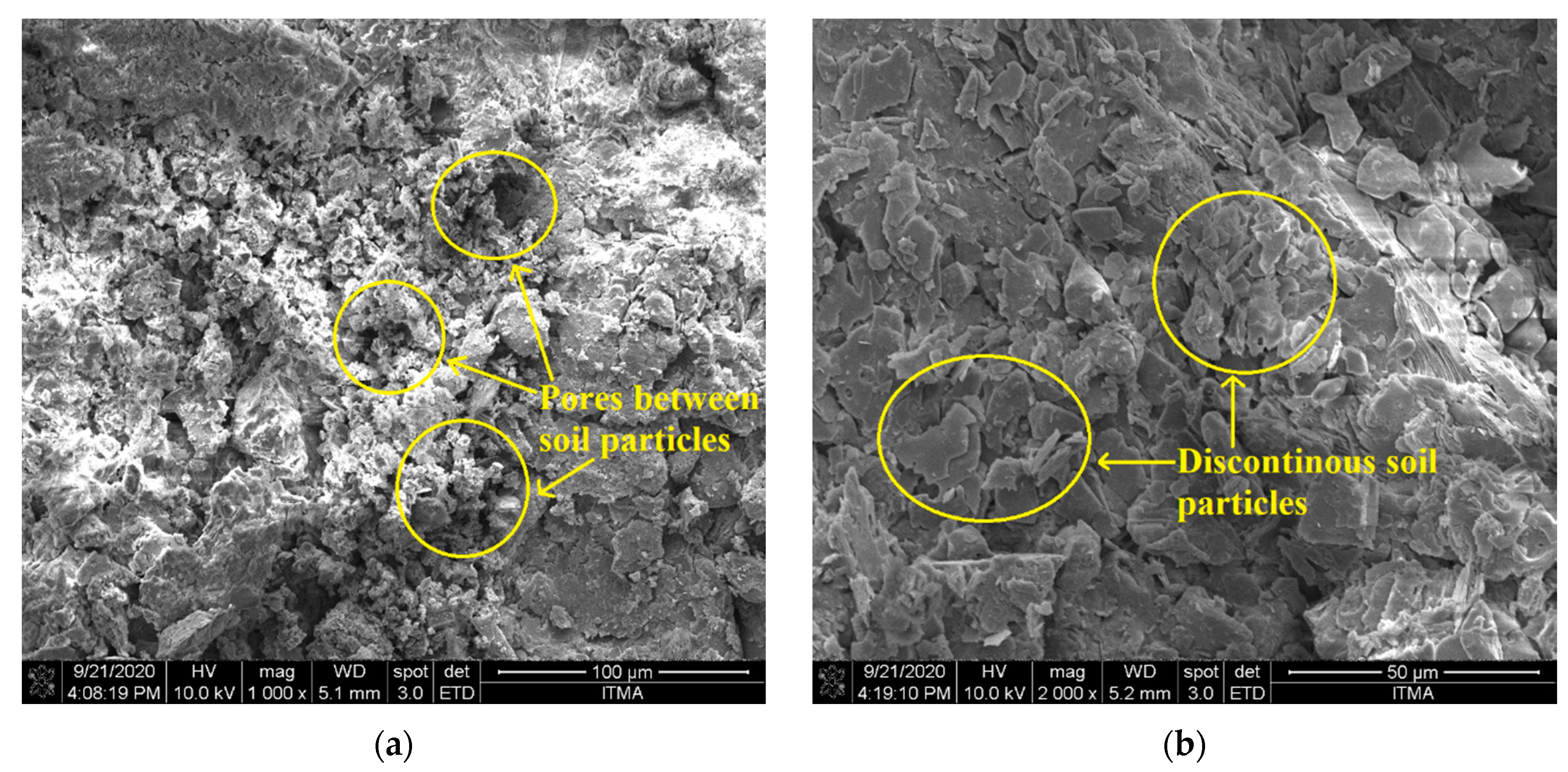
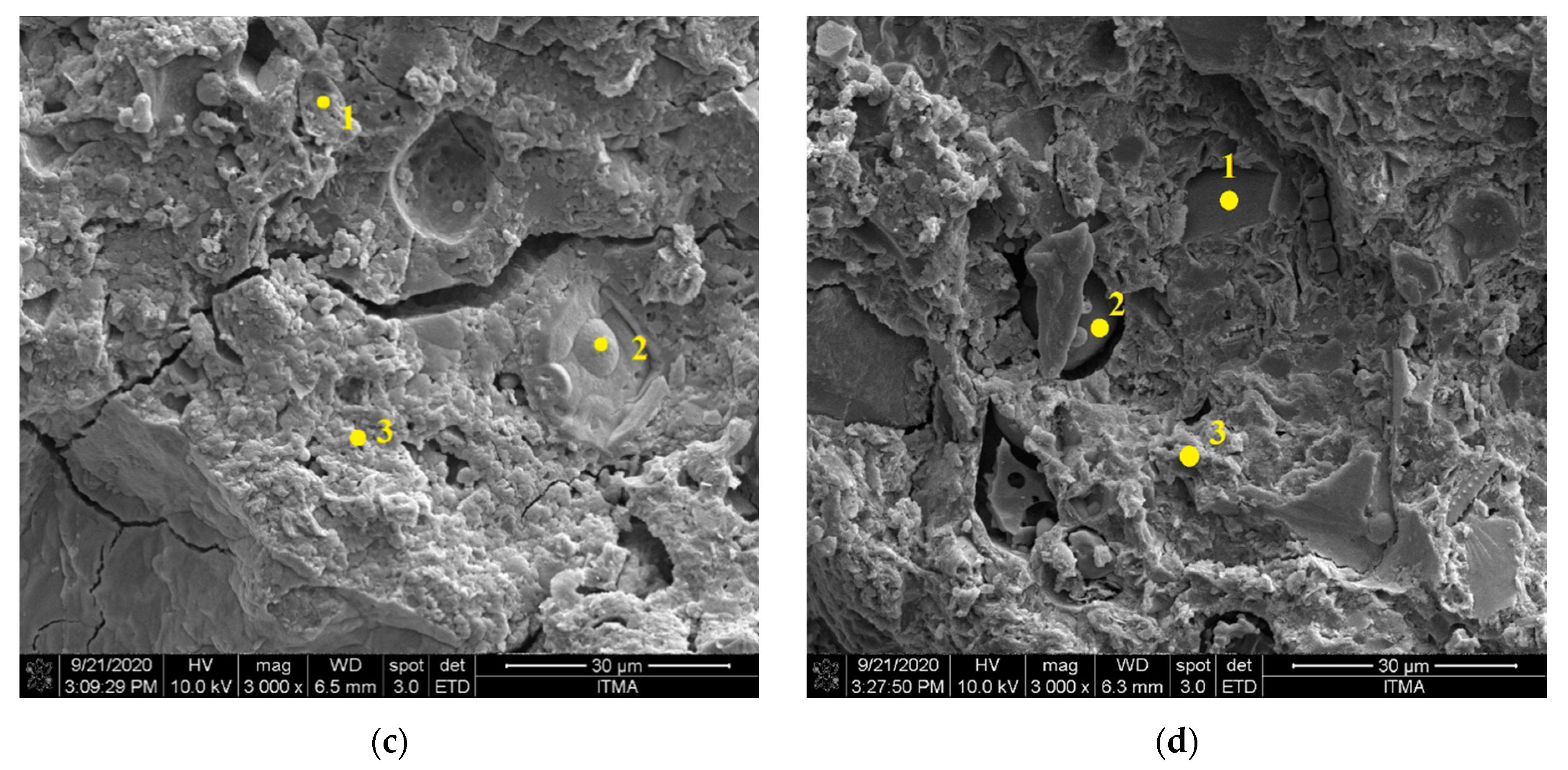
| Soil Properties | Unit | Standard | * S1 | * S2 |
|---|---|---|---|---|
| Initial moisture content | % | BS 1377: Part 2 | 22.9 | 98.9 |
| pH | - | BS 1377: Part 3 | 7.35 | 6.53 |
| Specific gravity | - | BS 1377: Part 2 | 2.77 | 2.80 |
| Plastic limit | % | BS 1377: Part 2 | 22.2 | 35.6 |
| Liquid limit | % | BS 1377: Part 2 | 41.6 | 80.7 |
| Plasticity Index | % | BS 1377: Part 2 | 19.4 | 45.1 |
| Shrinkage limit | % | BS 1377: Part 2 | 6.2 | 15.0 |
| USCS | - | - | CL | CH |
| Optimum moisture content | % | BS 1377: Part 4 | 15.5 | 34.4 |
| Maximum dry density | Mg/m3 | BS 1377: Part 4 | 1.76 | 1.31 |
| Component | Soil 1 (CL) | Soil 2 (CH) | Raw POFA (% by Mass) | Treated POFA (% by Mass) |
|---|---|---|---|---|
| Silicon dioxide (SiO2) | 36.71 | 42.46 | 39.23 | 43.52 |
| Aluminum oxide (Al2O3) | 27.18 | 22.65 | 26.2 | 24.7 |
| Calcium oxide (CaO) | 0.04 | 0.13 | 8.64 | 9.73 |
| Magnesium oxide (MgO) | 0.78 | 0.52 | 6.12 | 4.31 |
| Iron oxide (Fe2O3) | 9.35 | 7.69 | 5.99 | 6.68 |
| Potassium oxide (K2O) | 5.32 | 1.66 | 2.27 | 1.56 |
| Sulfur Trioxide (SO3) | 0.06 | 0.04 | 1.63 | 5.28 |
| Sodium oxide (Na2O) | - | - | 0.89 | 0.18 |
| LOI (%) | - | - | 8.79 | 1.26 |
| Series | Test Number | Curing Days | |
|---|---|---|---|
| UCS | DST | ||
| Soil 1 | Untreated CL | 7 & 28 | - |
| CL-G10PA | 7 & 28 | - | |
| CL-G20PA | 7 & 28 | - | |
| CL-G30PA | 7 & 28 | - | |
| CL-G40PA | 7 & 28 | - | |
| Soil 2 | Untreated CH | 7 & 28 | - |
| CH-G10PA | 7 & 28 | - | |
| CH-G20PA | 7 & 28 | - | |
| CH-G30PA | 7 & 28 | - | |
| CH-G40PA | 7 & 28 | - | |
| Test Series | OMC from Compaction Test (%) | Measured Water Content after Sample Preparation (UCS) (%) | Measured Water Content after Sample Preparation (DST) (%) | * Standard Deviation (UCS) (%) | * Standard Deviation (DST) (%) |
|---|---|---|---|---|---|
| Untreated CL | 15.5 | 12.8 | 14.8 | 2.7 | 0.7 |
| CL-G10PA | 14.6 | 11.3 | 13.5 | 3.3 | 1.1 |
| CL-G20PA | 13.4 | 11.1 | 13.1 | 2.3 | 0.3 |
| CL-G30PA | 13 | 12.6 | 12.7 | 0.4 | 0.3 |
| CL-G40PA | 12.8 | 12.2 | 12.2 | 0.6 | 0.6 |
| Untreated CH | 34.4 | 32.6 | 33.6 | 1.8 | 0.8 |
| CH-G10PA | 29.9 | 27.8 | 29.4 | 2.1 | 0.5 |
| CH-G20PA | 24.5 | 22.9 | 22.4 | 1.6 | 2.1 |
| CH-G30PA | 23 | 22.5 | 21.4 | 0.5 | 1.6 |
| CH-G40PA | 18.6 | 18.4 | 18.3 | 0.2 | 0.3 |
| Sample | Point Number | Si | Al | Na | O | Ca | Si/Al |
|---|---|---|---|---|---|---|---|
| CL-G40PA | 1.00 | 21.53 | 8.75 | 0.31 | 36.20 | 0.06 | 2.46 |
| 2.00 | 17.44 | 6.08 | 0.22 | 40.79 | 0.09 | 2.87 | |
| 3.00 | 9.60 | 2.90 | 4.27 | 33.56 | 1.38 | 3.31 | |
| CH-G40PA | 1.00 | 23.14 | 14.46 | 0.49 | 44.37 | 0.24 | 1.60 |
| 2.00 | 37.08 | 18.17 | 0.43 | 41.00 | 0.49 | 2.04 | |
| 3.00 | 21.95 | 8.34 | 5.10 | 39.82 | 2.32 | 2.63 |
Publisher’s Note: MDPI stays neutral with regard to jurisdictional claims in published maps and institutional affiliations. |
© 2021 by the authors. Licensee MDPI, Basel, Switzerland. This article is an open access article distributed under the terms and conditions of the Creative Commons Attribution (CC BY) license (http://creativecommons.org/licenses/by/4.0/).
Share and Cite
Khasib, I.A.; Daud, N.N.N.; Nasir, N.A.M. Strength Development and Microstructural Behavior of Soils Stabilized with Palm Oil Fuel Ash (POFA)-Based Geopolymer. Appl. Sci. 2021, 11, 3572. https://doi.org/10.3390/app11083572
Khasib IA, Daud NNN, Nasir NAM. Strength Development and Microstructural Behavior of Soils Stabilized with Palm Oil Fuel Ash (POFA)-Based Geopolymer. Applied Sciences. 2021; 11(8):3572. https://doi.org/10.3390/app11083572
Chicago/Turabian StyleKhasib, Isam Adnan, Nik Norsyahariati Nik Daud, and Noor Azline Mohd Nasir. 2021. "Strength Development and Microstructural Behavior of Soils Stabilized with Palm Oil Fuel Ash (POFA)-Based Geopolymer" Applied Sciences 11, no. 8: 3572. https://doi.org/10.3390/app11083572
APA StyleKhasib, I. A., Daud, N. N. N., & Nasir, N. A. M. (2021). Strength Development and Microstructural Behavior of Soils Stabilized with Palm Oil Fuel Ash (POFA)-Based Geopolymer. Applied Sciences, 11(8), 3572. https://doi.org/10.3390/app11083572





